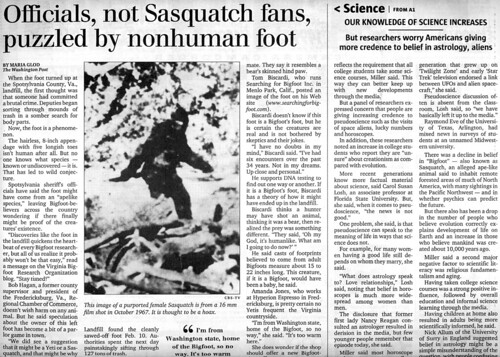Did you think that the new school board elected last year in Kansas would solve the political dilemmas in that state about evolution and creation? If so, you should reconsider your ideas about the appropriateness of elected officers defining education standards. The political pendulum will always swing, but the recent pass has opened a new can of worms. This time, defenders of evolution must deal with topics that has plagued this debate for a century: the problems of eugenics and social Darwinism.
First, a brief timeline from Kansas:
August '99: Kansas state school board de-emphasizes evolution in science standards.
August '00: Two conservative board members booted.
February '01: Evolution teaching restored.
August '02: Board split 5-5 on evolution.
August '04: Conservative resurgence led by Kathy Martin: Creationism 6, Evolution 4
February '05: Announcement that evolution will be reconsidered.
November '05: Science standards criticizing evolution approved.
August '06: Pro-evolution members regain majority.
February '07: Standards including evolution adopted.So what's the
fuss about?
Well, it turns out that not only is the new school board removing the creationist and intelligent design (ID) material from the science standards, they are removing references to the two most egregious examples of scientific misconduct from the twentieth century. It happens that in November 2005, the standards that inserted ID in the science curriculum, also for the first time included accounts of the Tuskegee syphilis study and Nazi human experimentation. My guess is that these were thrown in as tools to discount everyday science as immoral. In fact, it is the pseudoscience of eugenics that should be criticized! Now ID proponents, including Seattle's
Discovery Institute, are using this example of 'censorship' to point out that science education is being improperly sanitized.
So I guess we need to talk about what students actually learn about science in school... Every science student is introduced to the scientific method, but most scientists (and every philosopher of science) who read a high school textbook will agree that the accounts of the history of science are sanitized. It's not really until upper level college courses that budding young experimentalists learn that science is not exactly tidy. Experiments rarely work the way you think they will, and the discoveries that are so succinctly accounted in the textbooks were preceded by years of failure. That does not even touch on the fact that ethics and the responsible conduct of science are hardly ever taught on through the graduate levels. So is it a step in the right direction to include these crimes of human experimentation at the high school level?
I have to agree with these ID proponents that introducing students to horrors conducted in the name of science is acceptable. The examples of Nazi science and Tuskegee belong in science education within the context of learning about the practice of science. A condition of including these accounts should be a proper discussion of the
Nuremberg Code and the
Belmont Report as efforts to reach consensus on the limits of scientific experimentation.
As a final side note, I have yet to see an account accessible to the public that distinguishes evolutionary biology from social Darwinism and eugenics. Does anyone know of one?






